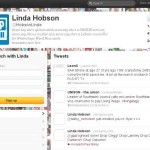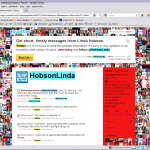David Cameron, when asked why he isn’t on Twitter, once memorably replied that “too many tweets might make a twat“. It’s a lesson well worth learning, although as a regular Twitter user myself I have to admit that it isn’t advice I’ve chosen to follow.
It’s advice that Linda Hobson might be wishing she’d taken, though. Linda is a UNISON activist and a Labour Councillor in Newcastle-on-Tyne. I know that because it used to say that on her Twitter profile. And the reason I haven’t just linked to it is because it doesn’t say that any more.
It all started with a tweet:
“Just put news on to see Thatcher – for a brief minute I celebrated her death – until reality struck – if only”
Some people, unsurprisingly, found that rather offensive. I’d have to say that I’ve seen worse, but it is the sort of thing that an elected representative is certainly best-advised to avoid saying.
Saying something stupid on Twitter is a hazard of the medium, though, and people more famous and more influential than Linda Hobson have said stupid things in the past. But when you do say something stupid on Twitter (or Facebook, or Google+, or wherever) then there are a few sensible courses of action to follow.
The first is to hope that nobody notices it. Make a few more posts in short order and hope that they push the unwanted one off the page before it gets spotted. That’s more likely to work on Google+ than the other two, of course, and it’s a slightly more risky course of action on Facebook because of the way that the Timeline works (although if it remains unnoticed for a day or two, you’re then safe to delete it). But, overall, if you can avoid it being remarked on then you’re home and dry.
If that doesn’t work (and I don’t know if Ms Hobson tried it, but if so it clearly didn’t for her), then there are two options for the next step.
The first is to front it out. Claim that you weren’t intending to be serious, and that people (including politicians and public figures) should be free to speak their mind even if that potentially offends people. If you’re really sure of your ground, then go on the attack – insinuate (or even state outright) that only your opponents could be so petty and small-minded as to get worked up about it. That can be particularly effective if the remark was intended to be funny; playing the Twitter Joke Trial card will generate sympathy even from those not normally inclined to support you. Or, if you were just being downright offensive, characterising it as a throwaway remark can have a similar effect.
The other option is to apologise. If you’re going to do that, do it properly, and do it before it looks as if you’re only doing it because your arm has been twisted or you fear the consequences if you don’t. In particular if you’re going to apologise, then that has to be the first thing you do. You can’t start off by fronting it out and then apologising later; that will just make it look as though the apology is forced. So make a decision early: Are you going to apologise or not? If the answer is not, that’s a final decision, you can’t go back on it with your credibility intact. But, on the other hand, you can combine an apology with a minimisation strategy if you apologise first. If your first tweet after the offensive one is something like
Sorry, that was really stupid of me. I completely withdraw that last remark
then you can follow it up with another one saying
I didn’t mean to be offensive, it was just a throwaway comment that came out wrong
and the chances are you’ll have successfully drawn the sting from it.
What you don’t do, though, is try to cover it up. Which is where Linda Hobson went wrong.
First, she deleted the offending tweet – despite the fact that someone had already taken a screenshot. Then she locked her Twitter feed, meaning nobody could view it without her permission. The next step was to edit her profile to remove any reference to UNISON and the council – which doesn’t, of course, remove Google’s thumbnail image or Bing’s cache of it.
Finally, she either deleted (or, more likely, renamed) the account so that it’s no longer accessible under the original name. Which is why I didn’t bother linking to it.
What that meant, of course, was that far from burying the unfortunate tweet, she simply drew even more attention to it and to herself. Councillors, MPs and activists on both sides of the political divide have lined up to condemn her, and I haven’t yet seen a single tweet in her defence. Which is a pity, really, because the original tweet wasn’t all that horrendous. As I said, I’ve seen worse (and if it was actually intended as a joke I genuinely would defend her right to say it). It was the hamfisted attempt to cover it up and try and pretend it had never been said which was the really stupid thing to do.
So, if you ever find yourself saying something dumb on Twitter, remember: You do have a choice on how to deal with it. Just don’t let it be Hobson’s choice.



